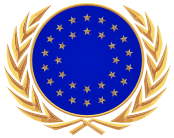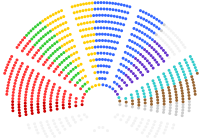European Parliament
| European Parliament | ||||
|---|---|---|---|---|

| ||||
| Type | ||||
| Type | Bicameral | |||
| Houses | European Council European Assembly | |||
| Leadership | ||||
| President of the Council |
AABB | |||
| Speaker of the Assembly |
AABB | |||
| Structure | ||||
| Membership | 811 Members of European Parliament 60 Councilors 751 Assemblymen | |||
European Council | ||||
| Political groups | ||||
European Assembly | ||||
| Political groups |
| |||
| Elections | ||||
| Last election | 6 November 1720 | |||
| Next election | 4 November 1725 | |||
| Meeting place | ||||
| Staatenverbundhaus | ||||
| Staatenverbundhaus Eurostadt | ||||
| Website | ||||
| link://parlament.europa.eu | ||||
The European Parliament is the parliament of the European Community. It is bicameral, consisting of a 58-Member (two from each member State) appointed upper house styled “European Council”, and a 751-Member elected lower house called “European Assembly”. The Consent of Council and Assembly is required in every instance of the legislative process, and before a Bill may become an Act of Parliament and thus a Law of the European Community, it must be approved by the High Chancellor of the European Community or, if disapproved by him, re-passed in the Council and Assembly by two-thirds of their respective Members.
History[edit | edit source]
XXXX
Powers and duties[edit | edit source]
XXXX
Enacting clause[edit | edit source]
The enacting clause used for legislative measures in the European Parliament depends on its use and purpose. For instance, for bills (Acts of Parliament), the enacting clause is, “Be it enacted by the Council and Assembly of the European Community in this present Parliament assembled”. For joint resolutions involving both Houses of Parliament, the enacting clause is, “Be it Resolved by the Council and Assembly of the European Community in this present Parliament assembled”; while the clause used for European Council resolutions is, “Be it Resolved by the Council of the European Community”; and “Be it Resolved by the Assembly of the European Community” is used for resolutions involving only the European Assembly.
The European Parliament’s enacting clauses are based on those used by the United States Congress (For Bills and Joint Resolutions: “Be it [enacted/resolved] by the Senate and House of Representatives of the the United States of North Aegea in Congress assembled”; and for Resolutions involving only one house: “Be it Resolved by the [Senate / House of Representatives] of the United States of North Aegea”).
Organization[edit | edit source]
XXXX
Comparisons[edit | edit source]
XXXX
Location[edit | edit source]
XXXX

